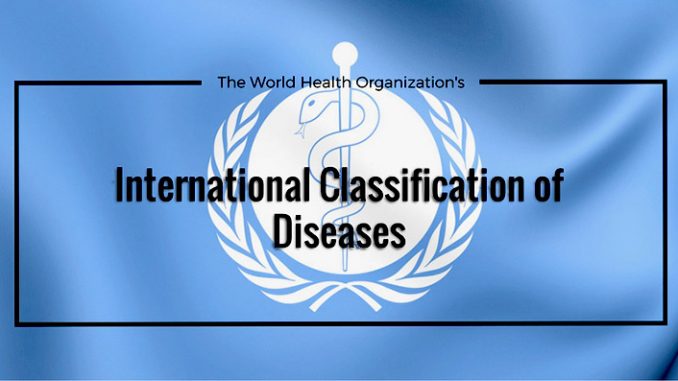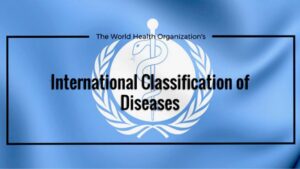I grew up in New Zealand and lived there until I was 12 years old. I remember one time my grandma came to visit us and I had never hung out with somebody older than the age of 60 before. When she came, I remember for the first time realizing that when I go and play with my brother, I could run around and roughhouse, but for my grandma, just getting up from a chair is really painful for her and that struck me as oh she has a disease like we should try to find a way to cure her so she can come and play with us” and then I remember asking my parents “what disease does grandma have” and they said, “she doesn’t have it, she’s just old” and I said “what disease is that”, They said “you do not understand it is a natural process” and as a kid, I thought that was stupid you know, why is it a natural process that we should all get this disease: Laura Deming, biological researcher, HT Summit 2017.
Theme of the month: Aging in the International Classification of Diseases (ICD)
What is a disease and what is the International classification of diseases?
A negative effect on the functioning of the body of an organism and its structure over a prolonged period of time is termed as a disease. Diseases come with a set of signs and symptoms and can either be caused externally (due to a pathogen) or internally (Immune system dysfunction). What is considered a disease changes with medical knowledge, but also with social and cultural evolutions. Historically, some poor areas considered obesity to be a sign of wealth, but in today’s world, we consider it to be a complex disease. In a similar context, homosexuality was also considered a “mental illness” but in 1973, the Diagnostic and Statistical Manual of Mental Disorders (DSM) removed “Ego-syntonic Homosexuality ».
In 1893, the Bertillon Classification of Causes of Death was introduced to the congress of the International Statistical Institute in Chicago by the French physician Jacques Bertillon and then adopted by several other countries. This system was based on the principle of “distinguishing between general diseases and those localized to a particular organ or anatomical site”. The first edition was published in 1900 and until the sixth version, very few changes were made. In the 6th edition, which came out in 1949, the title was modified to reflect the changes: International Statistical Classification of Diseases, Injuries, and Causes of Death (ICD). From this point onwards, World Health Organization (WHO) started preparing and publishing the revised versions of the ICD every 10 to 15 years.
Is aging a disease for the ICD?
The question to know if aging is a disease or not is a controversial one.
Aging is slowly killing all humans of the world (who are not dying of other causes). To know if it is a disease or not is a semantic question. What is sure is that is it the common cause of all age-related diseases and an aggravation factor of almost all illnesses.
ICD-10 (in 1990) already included code R54 for Age-related physical debility, R41.81 for Age-related cognitive decline, and F03 for Senile psychosis.
In the latest ICD-11, codes were introduced for a better understanding of the diseases and within that, XT9T code referred to “age-related” and MG2A, defined as “Old Age” which was later replaced by “Ageing-related decline of intrinsic capacity” after receiving criticism.
In fact, a group of scientists from Latin America opposed the idea of including the broad term of “Old Age” as a disease fearing reinforcement of the widely prevalent ageistic beliefs in society. They argue that aging might lead to some chronic medical or mental health conditions but that other factors play a much greater role in the disease causation rather than age itself. According to them, Frailty is a much more homogeneous and better-defined clinical entity.
Ageism can indeed be a problem in many societies. Still, the immense majority of sufferings due to aging come from diseases and infirmities due to senescence that we cannot yet escape.
On the other hand, a large group of scientists argued that categorizing aging as a disease with a “non-garbage” set of codes will result in new approaches and business models for addressing aging as a treatable condition, which will lead to both economic and healthcare benefits for all. This will also make it easy for researchers to conduct clinical trials as many countries strictly follow the ICD list for approvals and once a disease is recognized in this classification, it is easier for scientists to get their research funded.
Old Age might be an ageist term, but pathological processes of aging are a major risk factor. Work on developing new and improved therapies, with the purpose of slowing and reversing the damage done by aging is thus very important.
What is now recognized?
The following list of Aging-related codes which are included in ICD-11 was curated by Daria Khaltourina. XT9T is coded for age-related and it is in combination with codes for other diseases. This long list can be useful for researchers wanting to start clinical trials in one specific domain of aging.
- 3C0Y/Z&XT9T- Ageing-related other specified/unspecified diseases of the blood or blood-forming organs
- 4A20.Y/Z&XT9T- Ageing-related other specified/unspecified acquired immunodeficiencies (probably the most useful for clinical trials)
- 9E1Y/Z&XT9T- Ageing-related other specified/unspecified diseases of the visual system
- AC0Y/Z&XT9T- Ageing-related other specified/unspecified diseases of the ear or mastoid process
- BA00&XT9T- Ageing-related essential hypertension
- BA01&XT9T- Ageing-related hypertensive heart disease
- BA02&XT9T- Ageing-related hypertensive renal disease
- DE2Y/Z&XT9T- Ageing-related other specified/unspecified diseases of the digestive system
- CB7Z&XT9T- Ageing-related diseases of the respiratory system,
- BA80&XT9T- Ageing-related coronary atherosclerosis
- GA31.1&XT9T- Ageing-related secondary female infertility
- 8A00.2&XT9T- Ageing-related Parkinson-like syndrome/secondary parkinsonism
- 8A03.3&XT9T- Ageing-related acquired ataxia, unspecified
- FA01&XT9T- Ageing-related osteoarthritis of the knee
- 2F34&XT9T- Ageing-related benign neoplasm of male genital organs
- GB04.Z&XT9T- Ageing-related male infertility, unspecified.
- EE40.31- Age-related skin fragility
- EJ20- Photoaging of the skin
- MB21.0- Age-associated cognitive decline
- EE40.Y- Other specified atrophy or degeneration of dermal or subcutaneous connective tissue
- 9B10.0- Age-related cataract
- 9B75.0- Age-related macular degeneration
- MG2A- Old age Ageing-related decline of intrinsic capacity
Conclusion
ICD is important as it provides a common framework for recording and monitoring diseases universally between different countries, regions, and hospitals. This makes it easy to share and analysis of this data globally.
The WHO felt that “dialogue helped to find a way forward in this matter” and allocated a dedicated process for review of the term “old age” The review led to the retraction of the term “old age” as a category title and index listings from ICD-11, having been replaced by “aging-associated decline in intrinsic capacity”. Additionally, the use of the term “pathological” as an extension code (XT9T) to describe the normal process of “aging” has been replaced by the much more appropriate term, “biological”.
This inclusion was accomplished in large measure thanks to longevity advocacy, in particular, the years-long advocacy of the International Longevity Alliance and its core activists.
So, aging is now in the ICD and can be officially addressed as a medical condition.
The good news of the month: Aubrey de Grey’s announces rejuvenation trials on mice
The famous biogerontologist Aubrey de Grey’s was interviewed by Phil Newman, Editor-in-Chief of Longevity.Technology. He announced his new foundation will start « rejuvenation trials » on mice.
Innovative combined interventions on 18-month-old mice should be launched. The goal is to double the remaining life span.
This is excellent news. If successful, this type of experimentation offers perfect proof of the effectiveness of longevity therapy in an animal model.
For more information


